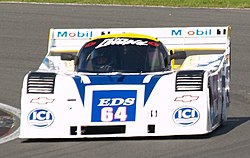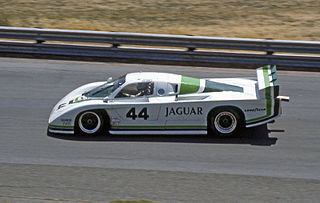
Bill Adam is a Canadian racing driver born in Airdrie, North Lanarkshire, Scotland.
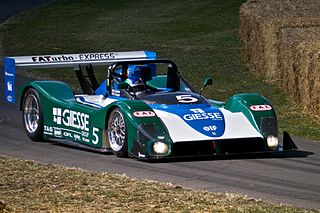
The Ferrari 333 SP is a sports prototype race car designed by Ferrari that was built by Italian race car manufacturer Dallara and later Michelotto to compete in the World Sports Car championship for Ferrari. Unveiled at the end of 1993, at the behest of amateur racer Giampiero Moretti, the 333 SP marked Ferrari's official return to sports car racing after a 20-year absence. The car was built to compete in the IMSA's new WSC class, which replaced the previous GTP cars.

Wayne Taylor Racing (WTR) is a sports car racing team that was founded in 2004 by racing driver Wayne Taylor. In 2023, the team began a partnership with Andretti Autosport that also saw them rebrand as Wayne Taylor Racing with Andretti Autosport (WTRAndretti). The team currently competes in the IMSA SportsCar Championship, campaigning the No. 10 Konica Minolta-sponsored Acura ARX-06 for Filipe Albuquerque and Ricky Taylor and the No. 40 DEX Imaging-sponsored Acura ARX-06 for Jordan Taylor and Louis Delétraz in the GTP class, and the No. 45 Lamborghini Huracán GT3 EVO2 for Kyle Marcelli and Danny Formal in the GTD class, also sponsored by DEX Imaging.

The Chevrolet Corvette C5-R is a grand touring racing car built by Pratt Miller and Chevrolet for competition in endurance racing. The car is based on the C5 generation of the Chevrolet Corvette sports car, yet is designed purely for motorsports use. It became one of the most successful cars in GT categories, with wins at the 24 Hours of Daytona, 12 Hours of Sebring, and 24 Hours of Le Mans, as well as championships in the American Le Mans Series. The Corvette C5-Rs debuted in 1999 and continues to be raced to this day in vintage racing events, although the C5-R was effectively replaced by the Corvette C6.R in 2005.
Wayne Taylor is a South African sports car racing driver and team owner. He won the 1996 and 2005 24 Hours of Daytona, and the 2005 Grand-Am Rolex Sports Car Series Daytona Prototype drivers' championship. He drove for SunTrust Racing with Max Angelelli. He co-drove in the 2006 International Race of Champions in the United States with Angelelli. Taylor now owns and manages his own team competing in the WeatherTech SportsCar Championship.

IMSA GT was a sports car racing series organized by International Motor Sports Association. Races took place primarily in the United States and occasionally in Canada.
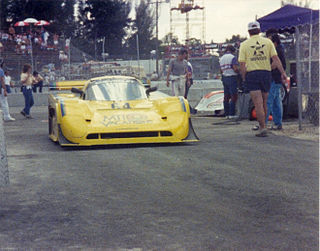
Bob Earl is an American former racing driver from Claremont, California. He began racing in Formula Ford in 1972 and was the 1973 national champion. In 1979 he made his professional debut in Formula Atlantic. In 1981 he became the only American to win the Macau Grand Prix, driving a modified Hayashi 320. At the time, the race was contested with Formula Atlantic cars.

The Chevrolet Corvette GTP was an American Grand Touring Prototype-class sports prototype racing car which successfully participated in the IMSA Camel GT from 1984 until 1989. The car was professionally fielded in competition as General Motors' Chevrolet Corvette C4 official factory team effort in the IMSA GTP class.
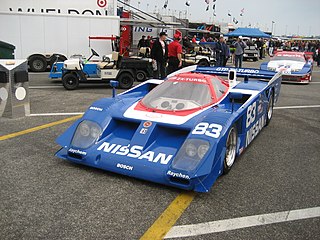
The Nissan GTP ZX-Turbo was a series of racing cars developed for Nissan Motors by Electramotive Engineering to compete in the IMSA GT Championship. Running from 1985 to 1990, they were known for being the first car to defeat the Porsche 962 which had dominated IMSA's premiere GTP category. This led to Nissan winning the constructor's championship and 12 Hours of Sebring in 1989 and 1990. During 1990, the GTP ZX-Turbo was replaced by the newer NPT-90.

The Nissan NPT-90 was a racing car developed in 1990 for Nissan Motors by Nissan Performance Technology Incorporated (NPTI), formerly known as Electramotive Engineering. It was a replacement for the highly successful GTP ZX-Turbo that had won the IMSA GT Championship in 1989. The NPT-90 would go on to win the championship in 1990 and 1991 before being retired by Nissan at the end of the 1992 season.

Pratt Miller Engineering, also known as Pratt & Miller, is an American company involved in the automotive and arms industries. It was founded by Gary Pratt and Jim Miller in 1989. A defense division was added in 2013 and the company was acquired by Oshkosh Corporation in 2020. The company is headquartered in the unincorporated community of New Hudson, in Lyon Township, Oakland County, Michigan. They are best known as service providers for many of General Motors' motorsports programs, including the operation of the Corvette Racing team.

The Riley & Scott Mark III was a sports prototype auto racing car developed by Bob Riley, Bill Riley and Mark Scott of Riley & Scott Cars Inc. Initially designed in 1993, the car was created for the World Sports Car (WSC) category which was to debut in the North American IMSA GT Championship during their 1994 season. It was not until 1995 that the first Mk III was completed, but the construction of further cars allowed a variety of teams to campaign in several North American and European racing series, including competing at the 24 Hours of Le Mans.

The Lola T600 was a racing car introduced in 1981 by Lola Cars as a customer chassis. It was the first GT prototype race car to incorporate ground-effect tunnels for downforce. The revolutionary aerodynamic design of the T600 was widely imitated throughout the 1980s by International Motor Sports Association (IMSA) and Group C prototype cars. The Lola T600 ran initially in the U.S.-based IMSA GT series and later in European Group C races.

The Eagle HF89 and its evolution, the Eagle HF90, is a racing car built and entered by Dan Gurney's All American Racers team, for the IMSA GT Championship. It was raced from 1989 until 1991 in IMSA's premier sports-car racing category, the GTP division. The design was also sometimes called the Eagle MkII.

The Eagle MkIII is a sports prototype racing car built by All American Racers in 1991 to IMSA GTP specifications. Powered by a turbocharged Toyota inline-4 engine, the car was campaigned in the IMSA Camel GT series by Dan Gurney's Toyota-sponsored AAR team from 1991 through to the end of 1993. The Eagle MkIII won 21 out of the 27 races in which it was entered and is considered one of the most successful and technologically advanced designs of the IMSA GTP era — "a car that proved so overwhelmingly dominant that the class for which it was created has now been assigned to history", according to Racer magazine.
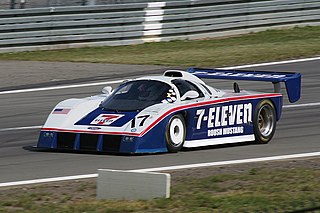
The Ford Mustang Maxum GTP was an IMSA GTP sports racing car designed by Paul Brown and constructed by Maxum Sports Cars. It was operated by Roush Racing during the 1987 season.
The Ford Mustang GTP was an American race car constructed to compete in the IMSA GTP series by Ford in 1983, based on the "Fox-Body" generation of the Ford Mustang road car. In 1983 the engine was a 1.7 liter twin turbo supplied by Zakspeed. In 1984 it used a destroked 2.1-litre 16 valve turbocharged variant of the 2.3 litre Ford Lima engine, capable of producing around 600 hp. The 2.1 litre engine is often misidentified as more common 2.1 litre variant of the BDA. Contrary to convention for an IMSA GTP car, the engine was fitted in the front of the car. Zakspeed would replace the car with the Ford Mustang Probe for 1985, while Roush Performance would build the no more successful V8-powered Ford Mustang Maxum GTP in 1987.
The Mazda GTP is an IMSA GTP race car that was built by Pierre Honegger in 1981. Based on a Mazda RX-7, the car initially competed in the GTX category as the Mazda RX-7 GTP, before it was rebuilt for the IMSA GTP category in 1983. Throughout its career, the car used a Mazda 13B Wankel rotary engine, similar to that used in the production RX-7s. Although the rotary-engined sports prototypes generally had a reputation of being very reliable, the Mazda GTP frequently failed to finish races, and was never able to better the eighth place achieved at the 1983 24 Hours of Daytona. In 1986, one car was purchased by Erie Scientific Racing, and rebuilt to become the Badger BB. This car was no more successful or reliable than its predecessor, and was last used in 1989, by which point it was owned by Jack Engelhardt. The other car, meanwhile, was rebuilt by Honegger into the Denali Speedcar, which was used with moderate success in 1986 and 1987.

The Mazda RT24-P also known as the MazdaRoad to 24 – Prototype is a Daytona Prototype International built to the 2017 IMSA DPi regulations. The car is designed and built by Mazda Motorsports, in collaboration with Multimatic Motorsports, and is based on the Riley-Multimatic Mk. 30 LMP2 chassis. This car is eligible for use in the Daytona Prototype International (DPi) class of the IMSA sanctioned WeatherTech Sportscar Championship. It made its racing debut at the 2017 Rolex 24 at Daytona, with SpeedSource Race Engineering, running under the Mazda Motorsports banner. There have been plans to open the car to customer sales, although none have come to fruition so far.

JDC–Miller MotorSports is a sports car racing team that currently competes in the IMSA WeatherTech SportsCar Championship. The team currently fields the No. 5 Porsche 963 full-time for Tijmen van der Helm and Mike Rockenfeller in the GTP class of the IMSA SportsCar Championship. JDC previously ran the No. 17 Unitronic/Liqui Moly Audi RS3 LMS TCR SEQ full-time for Chris Miller and Zikey Taylor in the Touring Car class in 2022.
